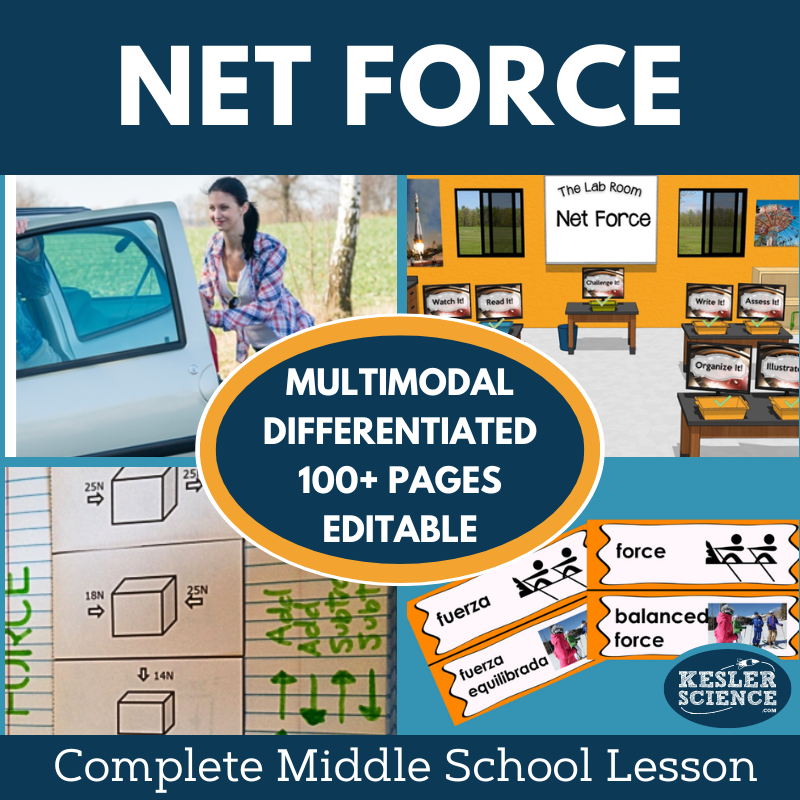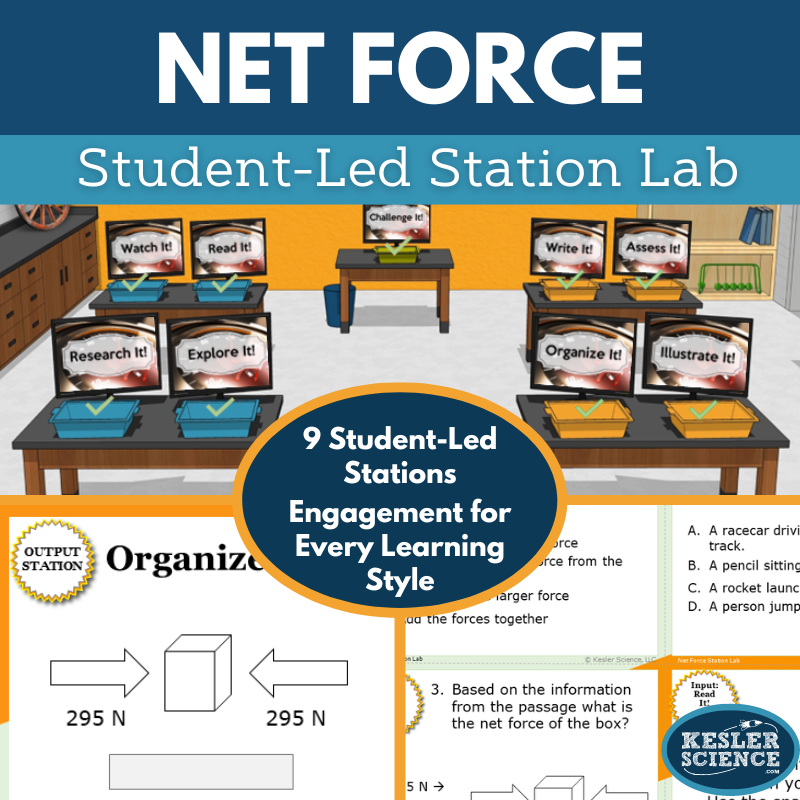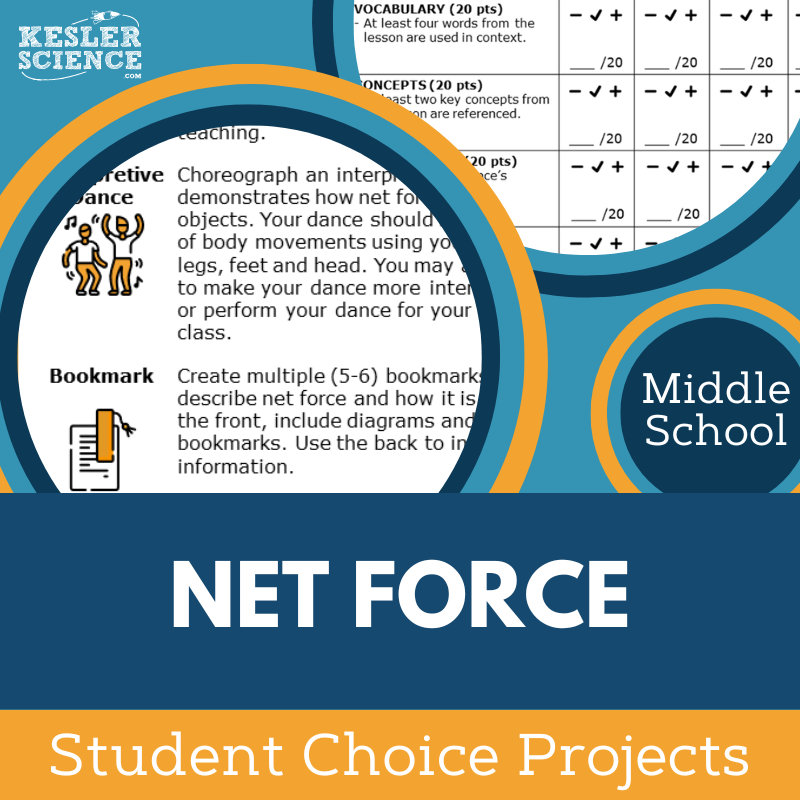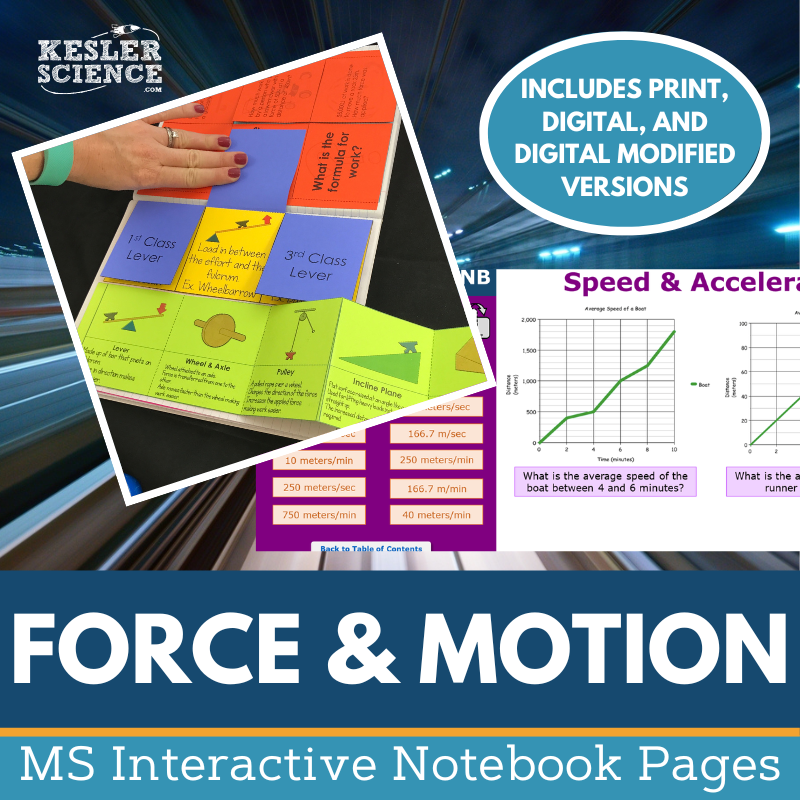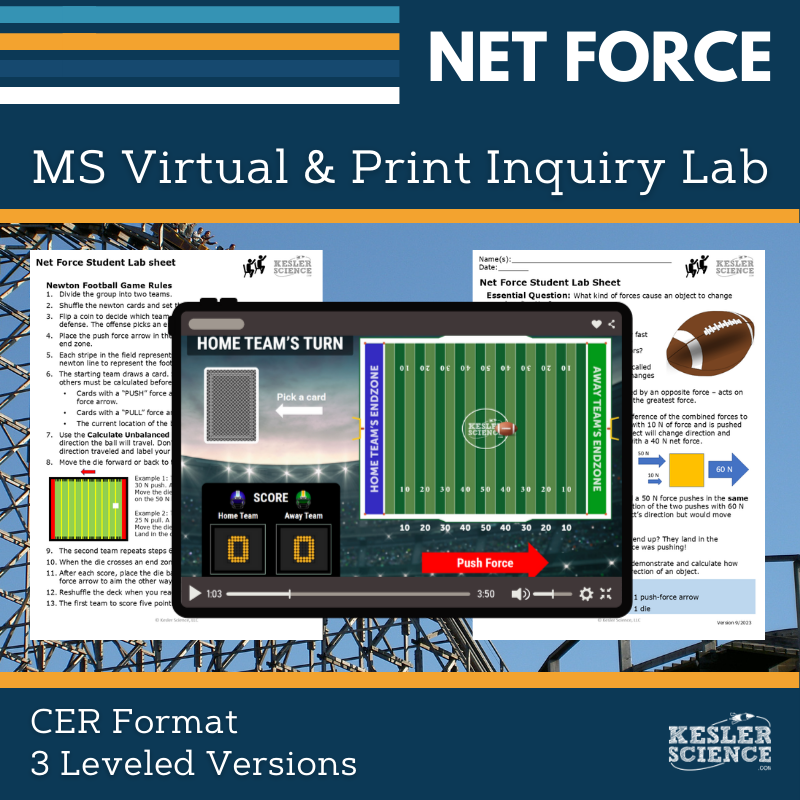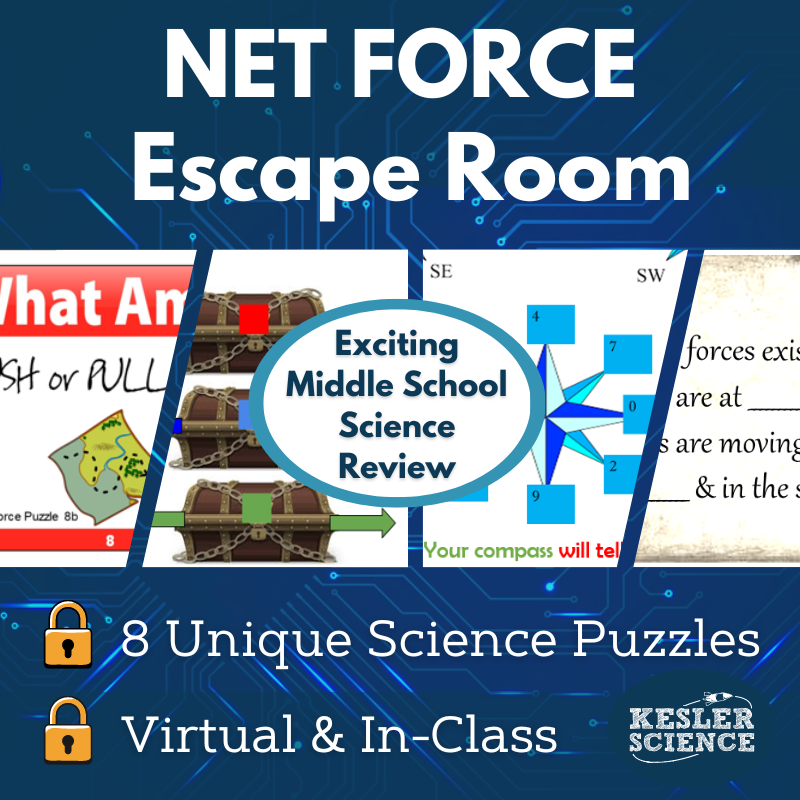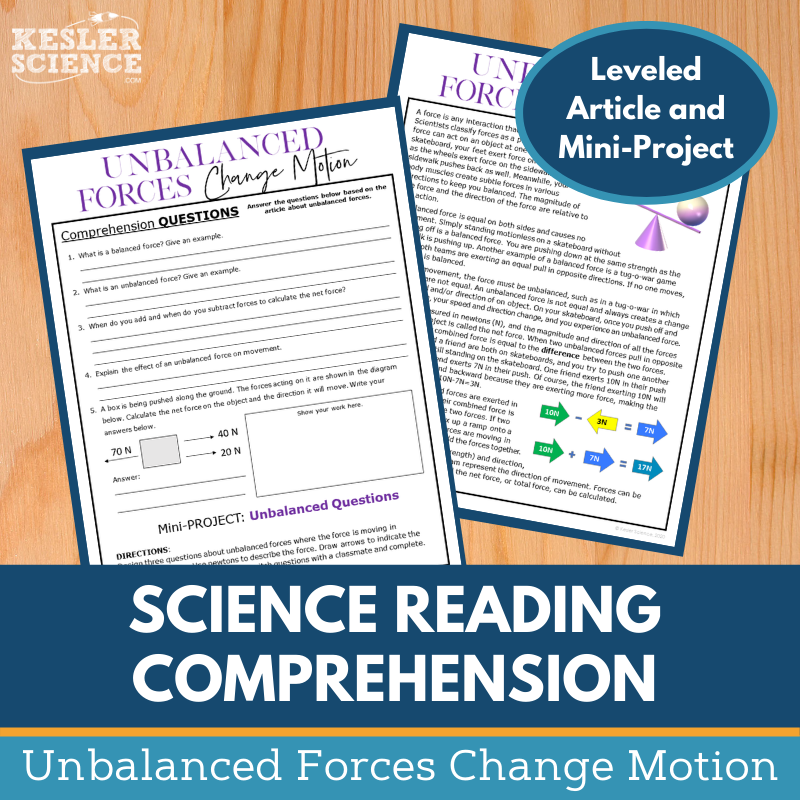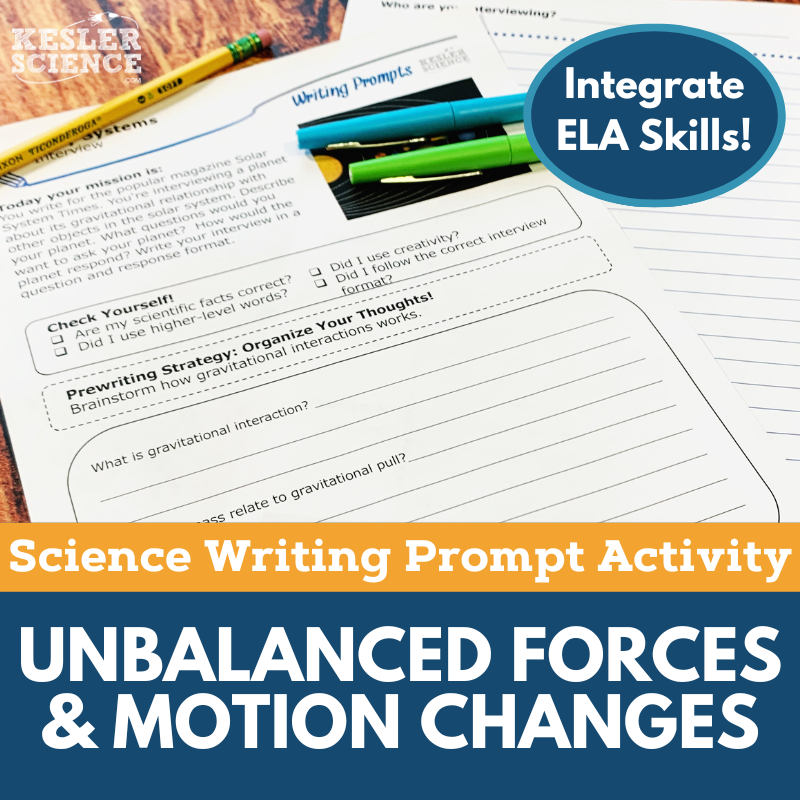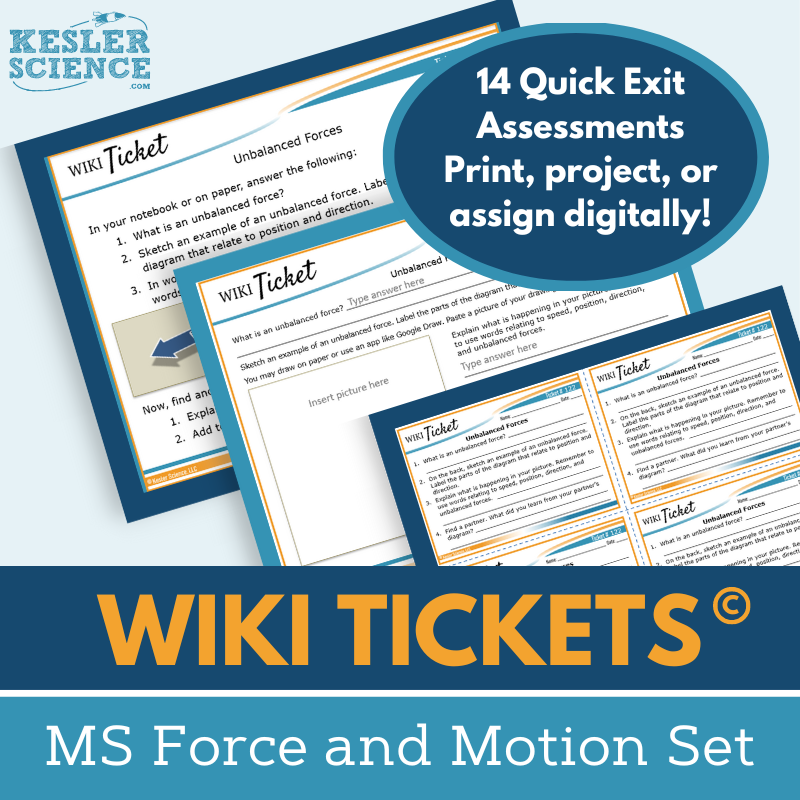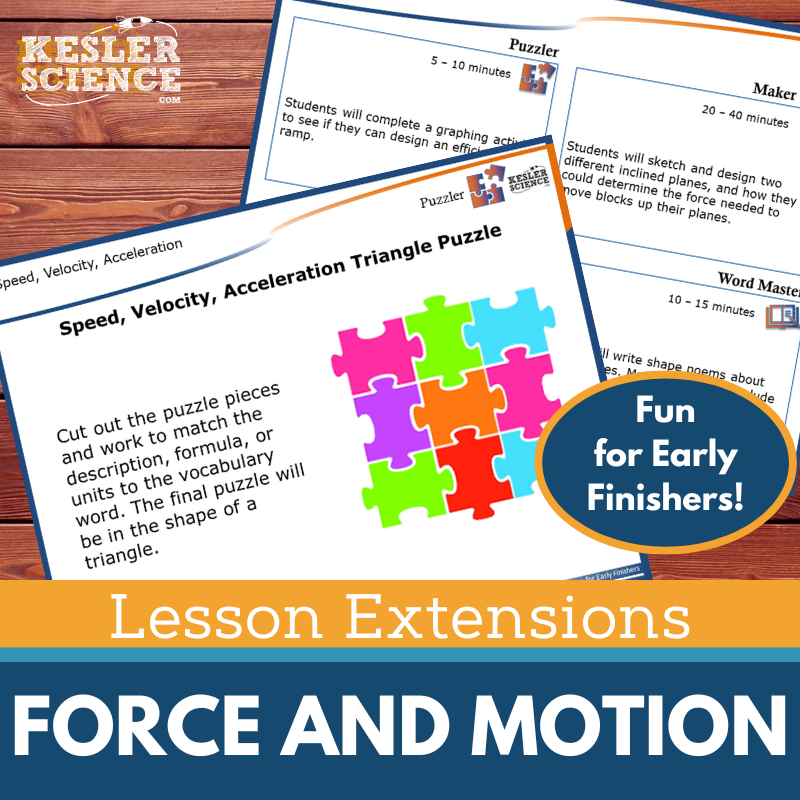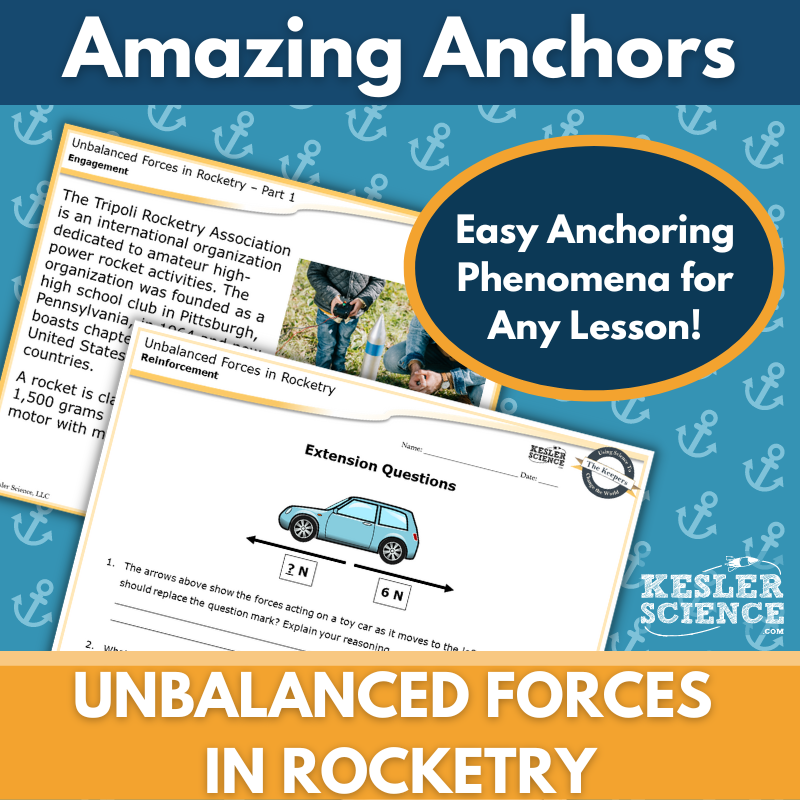Net Force Activities for Middle School Science
The Kesler Science Net Force resources provide a comprehensive, student-led learning experience on net force and motion. The resources below will give students a comprehensive understanding of net force. All of the following materials are also included in the Kesler Science Membership.
The Kesler Science Net Force Complete 5E Lesson offers everything needed to teach an engaging, multi-day lesson on net force. With minimal prep and student-led learning, this resource helps middle school students explore and understand unbalanced forces through interactive activities and diverse learning formats.
The lesson covers all stages of the 5E Model, including engaging students with vocabulary and activities, guiding them through differentiated stations, and providing opportunities to demonstrate knowledge via hands-on tasks. Students will explore concepts through various input and output stations, such as reading, researching, and illustrating net force.
Flexible and customizable, the lesson includes editable PowerPoints, interactive notebooks, and student-choice projects. It’s available in both printable and digital formats, with resources translated into Spanish, making it suitable for all learning environments and needs.
The Kesler Science Net Force Complete 5E Lesson offers everything needed to teach an engaging, multi-day lesson on net force. With minimal prep and student-led learning, this resource helps middle school students explore and understand unbalanced forces through interactive activities and diverse learning formats.
The lesson covers all stages of the 5E Model, including engaging students with vocabulary and activities, guiding them through differentiated stations, and providing opportunities to demonstrate knowledge via hands-on tasks. Students will explore concepts through various input and output stations, such as reading, researching, and illustrating net force.
Flexible and customizable, the lesson includes editable PowerPoints, interactive notebooks, and student-choice projects. It’s available in both printable and digital formats, with resources translated into Spanish, making it suitable for all learning environments and needs.
The Kesler Science Net Force Station Lab offers a modular, student-led approach to learning about force and motion. Designed for middle school students, this resource helps them explore Newton's third law by engaging in hands-on activities that foster independent learning, saving teachers prep time.
With eight differentiated stations and a bonus challenge station, students can tailor their experience. These stations include multimodal tasks such as reading, researching, experimenting, and watching videos to understand net force, followed by tasks like organizing, illustrating, and writing to demonstrate their learning.
The lab materials are easy to use both in-person and virtually, with tasks adaptable to either physical manipulatives or digital tools like PowerPoint and Google Slides, making it perfect for diverse learning environments.
The Kesler Science Net Force Station Lab offers a modular, student-led approach to learning about force and motion. Designed for middle school students, this resource helps them explore Newton's third law by engaging in hands-on activities that foster independent learning, saving teachers prep time.
With eight differentiated stations and a bonus challenge station, students can tailor their experience. These stations include multimodal tasks such as reading, researching, experimenting, and watching videos to understand net force, followed by tasks like organizing, illustrating, and writing to demonstrate their learning.
The lab materials are easy to use both in-person and virtually, with tasks adaptable to either physical manipulatives or digital tools like PowerPoint and Google Slides, making it perfect for diverse learning environments.
The Kesler Science Net Force Student Choice Projects give middle school students the freedom to choose from six project options or create their own. A grading rubric allows for assessments by teachers, peers, or students themselves, providing flexibility and personalization in the learning process.
With nine project options and a “design your own” project, the resource includes teacher directions and an editable rubric to assess vocabulary, concepts, and presentation. The projects are differentiated, offering options for both remediation and advanced students.
The projects require basic classroom supplies like paper, markers, and scissors, with many options for digital completion. Teachers can adapt the activities to fit their students' needs, ensuring an engaging experience for all learners.
The Kesler Science Net Force Student Choice Projects give middle school students the freedom to choose from six project options or create their own. A grading rubric allows for assessments by teachers, peers, or students themselves, providing flexibility and personalization in the learning process.
With nine project options and a “design your own” project, the resource includes teacher directions and an editable rubric to assess vocabulary, concepts, and presentation. The projects are differentiated, offering options for both remediation and advanced students.
The projects require basic classroom supplies like paper, markers, and scissors, with many options for digital completion. Teachers can adapt the activities to fit their students' needs, ensuring an engaging experience for all learners.
The Kesler Science Force and Motion Interactive Notebook offers a dynamic way to engage students in learning key physics concepts. This resource includes both print and digital versions, making it adaptable for any classroom setting, including traditional, 1:1 environments, and distance learning.
The notebook covers essential topics such as speed, velocity, acceleration, Newton’s laws, simple machines, and motion graphing. The digital version includes a PowerPoint file that can be uploaded to platforms like Google Slides, MS Teams, or Canvas. It also features reflection pages, space for note-taking, and a modified version for students with accommodations.
For in-person learning, the paper version provides blank and pre-filled templates with color photos for easy use. Whether online or in the classroom, the Force and Motion Interactive Notebook is a versatile tool that helps students actively engage with and understand the material.
The Kesler Science Force and Motion Interactive Notebook offers a dynamic way to engage students in learning key physics concepts. This resource includes both print and digital versions, making it adaptable for any classroom setting, including traditional, 1:1 environments, and distance learning.
The notebook covers essential topics such as speed, velocity, acceleration, Newton’s laws, simple machines, and motion graphing. The digital version includes a PowerPoint file that can be uploaded to platforms like Google Slides, MS Teams, or Canvas. It also features reflection pages, space for note-taking, and a modified version for students with accommodations.
For in-person learning, the paper version provides blank and pre-filled templates with color photos for easy use. Whether online or in the classroom, the Force and Motion Interactive Notebook is a versatile tool that helps students actively engage with and understand the material.
The Kesler Science Net Force Inquiry Lab aligns with standards related to force and motion by engaging students in identifying and calculating the effects of unbalanced forces on an object’s direction and speed. Students will participate in a hands-on board game or a fully interactive digital lab to explore how forces affect motion. Both formats include comprehension questions, C.E.R. prompts, and reflection opportunities to deepen understanding.
Differentiated versions are provided for all learners: a Dependent version with guided inquiry, a Modified version with structured supports like sentence stems, and an Independent version where students make their own procedural decisions. The print version uses materials like Newton’s Football Field, a die, and push-force arrows, while the digital version features a video-led lab involving balloon propulsion and built-in interactive activities.
Editable files are included for maximum flexibility and compatibility with Google Slides and PowerPoint. Teacher resource pages, answer keys, and differentiated lab sheets are provided to simplify preparation and support instruction. This lab offers a multimodal, student-centered experience ideal for middle school science classrooms.
The Kesler Science Net Force Inquiry Lab aligns with standards related to force and motion by engaging students in identifying and calculating the effects of unbalanced forces on an object’s direction and speed. Students will participate in a hands-on board game or a fully interactive digital lab to explore how forces affect motion. Both formats include comprehension questions, C.E.R. prompts, and reflection opportunities to deepen understanding.
Differentiated versions are provided for all learners: a Dependent version with guided inquiry, a Modified version with structured supports like sentence stems, and an Independent version where students make their own procedural decisions. The print version uses materials like Newton’s Football Field, a die, and push-force arrows, while the digital version features a video-led lab involving balloon propulsion and built-in interactive activities.
Editable files are included for maximum flexibility and compatibility with Google Slides and PowerPoint. Teacher resource pages, answer keys, and differentiated lab sheets are provided to simplify preparation and support instruction. This lab offers a multimodal, student-centered experience ideal for middle school science classrooms.
The Kesler Science Net Force Escape Room offers an immersive and interactive way for students to demonstrate their knowledge of net force, balanced, and unbalanced forces. The activity includes eight puzzles that can be used independently or in any order, giving teachers flexibility for various class lengths.
The escape room can be run with simple materials like manila envelopes or more authentically with locks and storage boxes. For online learning, there are digital versions of the puzzles available in PowerPoint and Google Slides formats, ensuring students can participate in a virtual setting.
Included in the resource are teacher directions, answer keys, editable materials, a digital answer sheet for Google Classroom, and 30 signs for a fun post-challenge photo. This engaging activity encourages critical thinking while making learning about net forces exciting.
The Kesler Science Net Force Escape Room offers an immersive and interactive way for students to demonstrate their knowledge of net force, balanced, and unbalanced forces. The activity includes eight puzzles that can be used independently or in any order, giving teachers flexibility for various class lengths.
The escape room can be run with simple materials like manila envelopes or more authentically with locks and storage boxes. For online learning, there are digital versions of the puzzles available in PowerPoint and Google Slides formats, ensuring students can participate in a virtual setting.
Included in the resource are teacher directions, answer keys, editable materials, a digital answer sheet for Google Classroom, and 30 signs for a fun post-challenge photo. This engaging activity encourages critical thinking while making learning about net forces exciting.
This Unbalanced Forces Change Motion Science Reading Comprehension Lesson helps students understand how unbalanced forces affect the motion of objects. Designed for middle school, the leveled article explores changes in speed and direction due to force and is paired with comprehension questions and a creative mini-project where students design three motion scenarios.
The resource includes two Lexile-leveled versions of the article (1100–1300), five to seven comprehension questions, and an interactive activity to extend learning. A Cornell notes template and visually engaging graphics support student engagement, and all materials are designed for easy print or digital use.
Ideal for sub plans, virtual learning, or whole-class instruction, this lesson builds science literacy and reading comprehension while encouraging classroom discussions and critical thinking. It integrates smoothly with platforms like Google Classroom and MS Teams, making it flexible for both in-person and remote settings.
This Unbalanced Forces Change Motion Science Reading Comprehension Lesson helps students understand how unbalanced forces affect the motion of objects. Designed for middle school, the leveled article explores changes in speed and direction due to force and is paired with comprehension questions and a creative mini-project where students design three motion scenarios.
The resource includes two Lexile-leveled versions of the article (1100–1300), five to seven comprehension questions, and an interactive activity to extend learning. A Cornell notes template and visually engaging graphics support student engagement, and all materials are designed for easy print or digital use.
Ideal for sub plans, virtual learning, or whole-class instruction, this lesson builds science literacy and reading comprehension while encouraging classroom discussions and critical thinking. It integrates smoothly with platforms like Google Classroom and MS Teams, making it flexible for both in-person and remote settings.
The Unbalanced Forces and Motion Changes science writing activity engages middle school students through a creative skit or drama format, allowing them to demonstrate their understanding of physical science concepts in a fun and meaningful way. Designed for both print and digital use, this low-prep, student-centered exercise encourages science reasoning and supports flexible instruction whether in the classroom or during virtual learning.
This NGSS- and TEKS-aligned resource includes detailed teacher directions, full and half-sheet rubrics, and multiple handout options. Students can complete the activity using full-sized printables or digital slides in PowerPoint or Google Slides, with built-in self-checks and pre-writing tools to guide the process. The flexible design also makes it easy to incorporate into writing journals or interactive notebooks.
Ideal as a cross-curricular writing activity, the skit prompt works well for elaboration, review, early finisher enrichment, make-up work, or TELPAS writing samples. Students should have prior knowledge of unbalanced forces or access to reference materials. This engaging project also doubles as a creative classroom display or student writing anthology piece.
The Unbalanced Forces and Motion Changes science writing activity engages middle school students through a creative skit or drama format, allowing them to demonstrate their understanding of physical science concepts in a fun and meaningful way. Designed for both print and digital use, this low-prep, student-centered exercise encourages science reasoning and supports flexible instruction whether in the classroom or during virtual learning.
This NGSS- and TEKS-aligned resource includes detailed teacher directions, full and half-sheet rubrics, and multiple handout options. Students can complete the activity using full-sized printables or digital slides in PowerPoint or Google Slides, with built-in self-checks and pre-writing tools to guide the process. The flexible design also makes it easy to incorporate into writing journals or interactive notebooks.
Ideal as a cross-curricular writing activity, the skit prompt works well for elaboration, review, early finisher enrichment, make-up work, or TELPAS writing samples. Students should have prior knowledge of unbalanced forces or access to reference materials. This engaging project also doubles as a creative classroom display or student writing anthology piece.
The Kesler Science formative Force and Motion WIKI ticket assessments offer flexible, engaging options for checking student understanding. This set includes 14 assessments, each with five formats: a full-screen display version for projection, three handout sizes, and an interactive digital version (PPT or Google Slides). These assessments are aligned with NGSS and TEKS standards, covering topics like speed, unbalanced forces, and Newton’s laws.
WIKI Tickets provide a fun, interactive way to gauge students' progress, perfect for use as exit tickets, bellringers, or formative assessments during lessons. The resource works well in both traditional and virtual learning environments, allowing for easy adaptation to any classroom setting.
Each topic includes multiple formats, making it easy to implement in-person or online. Whether projected in class or completed digitally, these colorful assessments allow for continuous student engagement and real-time understanding checks, helping you monitor student progress throughout the unit.
The Kesler Science formative Force and Motion WIKI ticket assessments offer flexible, engaging options for checking student understanding. This set includes 14 assessments, each with five formats: a full-screen display version for projection, three handout sizes, and an interactive digital version (PPT or Google Slides). These assessments are aligned with NGSS and TEKS standards, covering topics like speed, unbalanced forces, and Newton’s laws.
WIKI Tickets provide a fun, interactive way to gauge students' progress, perfect for use as exit tickets, bellringers, or formative assessments during lessons. The resource works well in both traditional and virtual learning environments, allowing for easy adaptation to any classroom setting.
Each topic includes multiple formats, making it easy to implement in-person or online. Whether projected in class or completed digitally, these colorful assessments allow for continuous student engagement and real-time understanding checks, helping you monitor student progress throughout the unit.
The Kesler Science Force and Motion Lesson Extensions are designed to engage fast finishers with critical thinking and creativity. These activities offer a mix of rigor and fun, providing an ideal way to wrap up lessons or keep students occupied during testing. The activities help deepen understanding of force and motion while aligning with NGSS and TEKS standards.
Each extension includes four different types of activities: Puzzler, Maker Space, Tech Connection, and Word Master. These activities are student-driven, allowing for personalized learning experiences. Whether it’s solving puzzles, building models, exploring digital media, or expressing ideas through creative writing, each activity promotes critical thinking and hands-on engagement.
These extensions come with teacher directions, answer keys, and printable versions. The materials are flexible, allowing for use in both digital and in-person settings. Perfect for advanced learners or as supplementary activities, they provide a structured yet engaging way to dive deeper into topics like gravity, Newton’s laws, and speed.
The Kesler Science Force and Motion Lesson Extensions are designed to engage fast finishers with critical thinking and creativity. These activities offer a mix of rigor and fun, providing an ideal way to wrap up lessons or keep students occupied during testing. The activities help deepen understanding of force and motion while aligning with NGSS and TEKS standards.
Each extension includes four different types of activities: Puzzler, Maker Space, Tech Connection, and Word Master. These activities are student-driven, allowing for personalized learning experiences. Whether it’s solving puzzles, building models, exploring digital media, or expressing ideas through creative writing, each activity promotes critical thinking and hands-on engagement.
These extensions come with teacher directions, answer keys, and printable versions. The materials are flexible, allowing for use in both digital and in-person settings. Perfect for advanced learners or as supplementary activities, they provide a structured yet engaging way to dive deeper into topics like gravity, Newton’s laws, and speed.
This Amazing Anchors Phenomenon Lesson introduces unbalanced forces through a real-world connection with the Tripoli Rocketry Association. Students begin with an engaging introductory reading, followed by comprehension and extension questions to activate prior knowledge. A second, explanatory reading breaks down the science behind unbalanced forces, reinforcing key concepts and encouraging deeper learning through additional questions.
This TEKS-aligned, no-prep resource is designed to bookend a core lesson, making it ideal for the Engagement and Elaborate phases of the 5E Instructional Model. It includes teacher directions with answer keys, editable materials, projection slides, and full- and half-sheet handouts for interactive notebooks. Both print and digital formats are included for flexible classroom or virtual use.
Differentiation is built in, with two versions of the readings to support a variety of student needs. The modified version offers sentence starters and simplified language to guide learners through the comprehension process, ensuring accessibility for all students.
This Amazing Anchors Phenomenon Lesson introduces unbalanced forces through a real-world connection with the Tripoli Rocketry Association. Students begin with an engaging introductory reading, followed by comprehension and extension questions to activate prior knowledge. A second, explanatory reading breaks down the science behind unbalanced forces, reinforcing key concepts and encouraging deeper learning through additional questions.
This TEKS-aligned, no-prep resource is designed to bookend a core lesson, making it ideal for the Engagement and Elaborate phases of the 5E Instructional Model. It includes teacher directions with answer keys, editable materials, projection slides, and full- and half-sheet handouts for interactive notebooks. Both print and digital formats are included for flexible classroom or virtual use.
Differentiation is built in, with two versions of the readings to support a variety of student needs. The modified version offers sentence starters and simplified language to guide learners through the comprehension process, ensuring accessibility for all students.
Year-Round Resources
These year-round activities will increase your students' understanding of many middle school science topics. All of these activities are also included in the Kesler Science Membership.
Visual Data & Graphing
You're not alone if your students struggle with understanding graphs, charts, and tables. It's a skill that takes an enormous amount of practice. This resource will help students build a strong foundation in analyzing data and creating their own data visualizations.
Bell Ringers and Warm-Ups
These middle school science bell ringers are an excellent way to engage your students as soon as they walk into your classroom. This comprehensive FULL YEAR resource includes everything you need to start off each science class with an interesting warm-up activity.
Review Board Games
Each game board has been carefully designed to keep students engaged. There are 10 different action spaces on each board and dozens of question cards. All of the actions are related to science concepts and keep the students motivated throughout the game.
Each game is ready to play. Simply print out the board and the cards and let the students enjoy reviewing nine different units.
Essential Questions
Below are the essential questions associated with the lessons and activities included in this unit. This topic is only one of more than 100 middle school science topics included in the Kesler Science Membership.
-
What are ways to demonstrate how unbalanced forces change the speed or direction of an object’s motion?
-
What are ways to calculate how unbalanced forces change the speed or direction of an object’s motion?
Kesler Science Membership
Imagine never having to search for another middle school science lesson again. The membership gives you access to ALL of the Kesler Science products in one place (Yes, including everything above).
Say goodbye to long hours of lesson prep.

